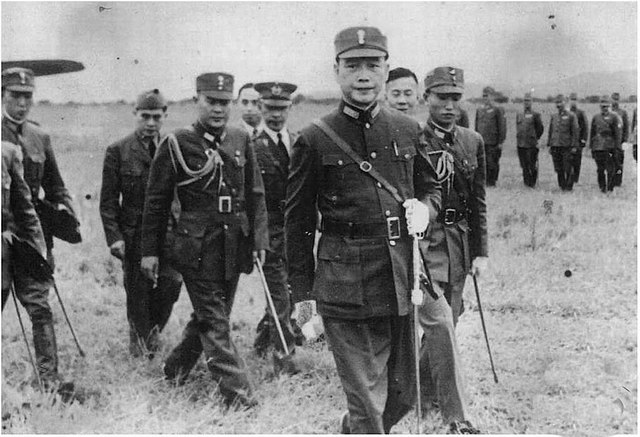Collaboration with Imperial Japan
Throughout World War II, the Empire of Japan created a number of puppet states that played a noticeable role in the war by collaborating with Imperial Japan. With promises of "Asia for the Asiatics" cooperating in a Greater East Asia Co-Prosperity Sphere, Japan also sponsored or collaborated with parts of nationalist movements in several Asian countries colonised by European empires or the United States. The Japanese recruited volunteers from several occupied regions and also from among Allied prisoners-of-war.
Korean volunteers of the Imperial Japanese Army, January 1943
The Burma Independence Army enters Rangoon during the Japanese invasion of Burma, early 1942
Troops of the Imperial Japanese Army and the Indian National Army on the Burma–India border, March 1943
Wang Jingwei with officers of the Collaborationist Chinese Army in the early years of the Second Sino-Japanese War, late 1930s
Greater East Asia Co-Prosperity Sphere
The Greater East Asia Co-Prosperity Sphere , also known as the GEACPS, was a pan-Asian union that the Empire of Japan tried to establish. Initially, it covered Japan, Manchukuo, and China, but as the Pacific War progressed, it also included territories in Southeast Asia. The term was first coined by Minister for Foreign Affairs Hachirō Arita on June 29, 1940.
1935 propaganda poster of Manchukuo promoting harmony between Japanese, Chinese, and Manchu. The caption from right to left says: "With the help of Japan, China, and Manchukuo, the world can be in peace." The flags shown are, right to left: the "Five Races Under One Union" flag of China, the flag of Japan, and the flag of Manchukuo.
The Greater East Asia Conference in November 1943. Participants left to right: Ba Maw, Zhang Jinghui, Wang Jingwei, Hideki Tojo, Wan Waithayakon, José P. Laurel, and Subhas Chandra Bose
Fragment of a Japanese propaganda booklet published by the Tokyo Conference (1943), depicting scenes of situations in Greater East Asia, from the top, left to right: the Japanese occupation of Malaya, Thailand under Plaek Phibunsongkram gaining the territories of Saharat Thai Doem, the Republic of China under Wang Jingwei allied with Japan, Subhas Chandra Bose forming the Provisional Government of Free India, the State of Burma gaining independence under
A Japanese 10 sen stamp from 1942 depicting the approximate extension of the Greater East Asia Co-Prosperity Sphere








